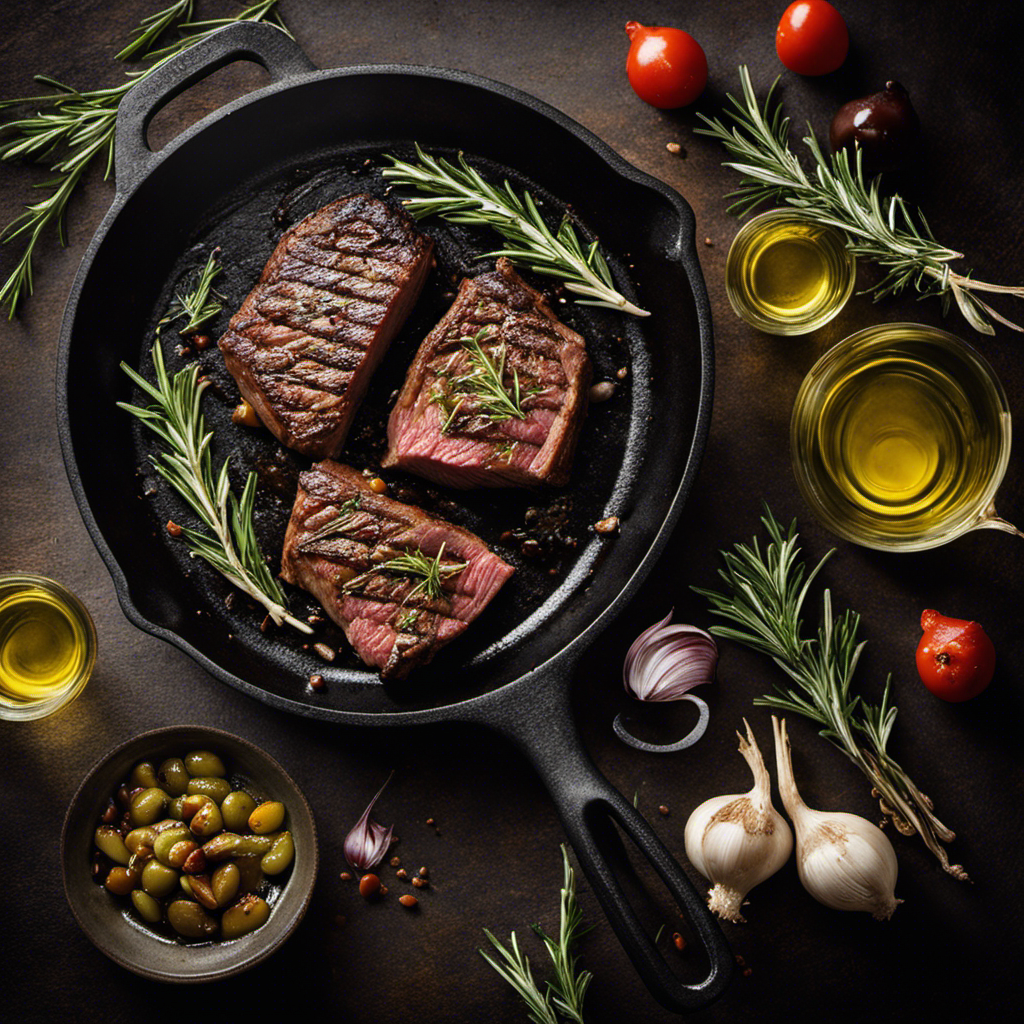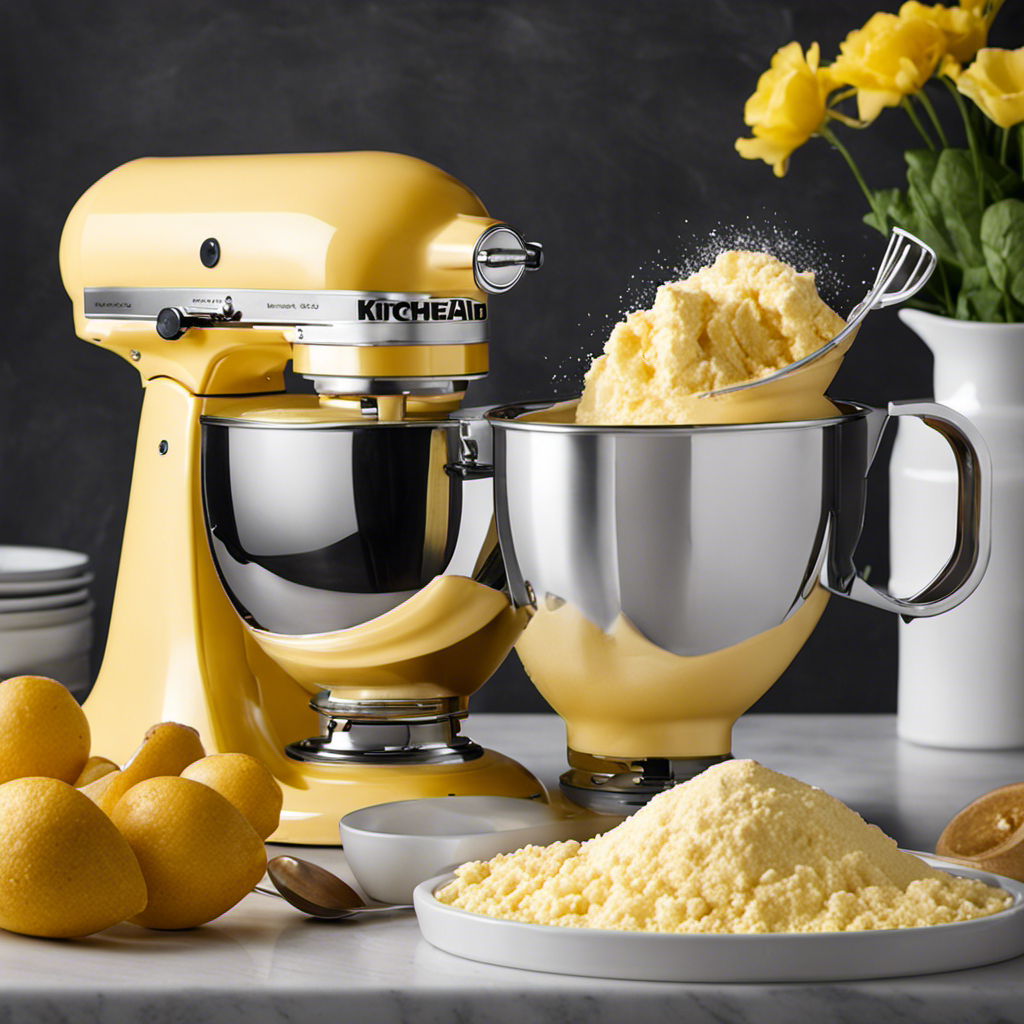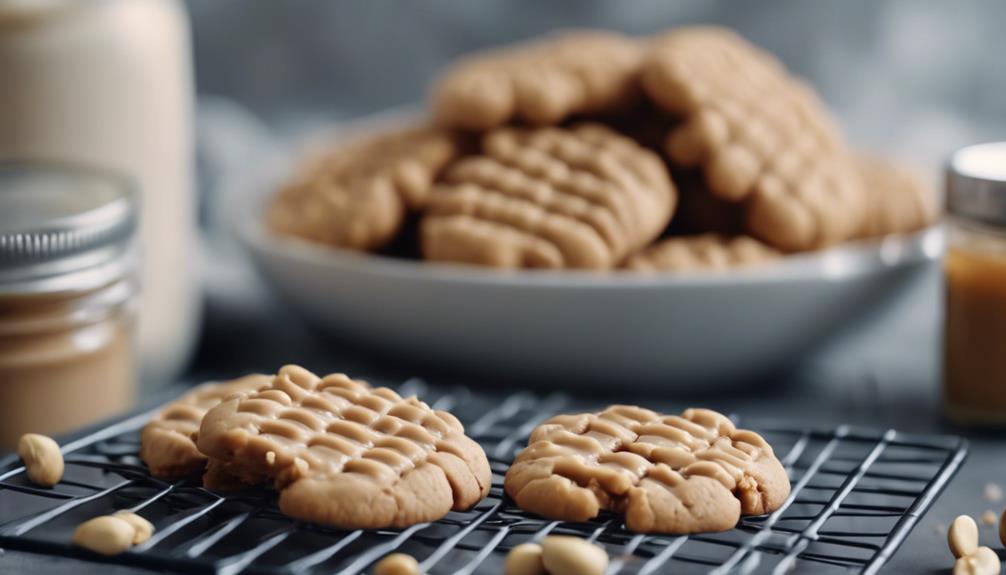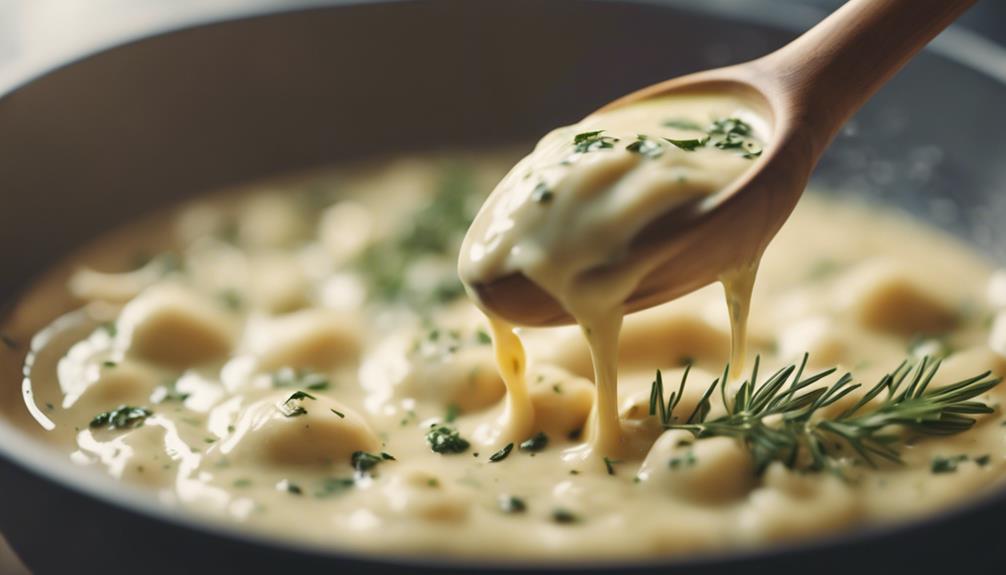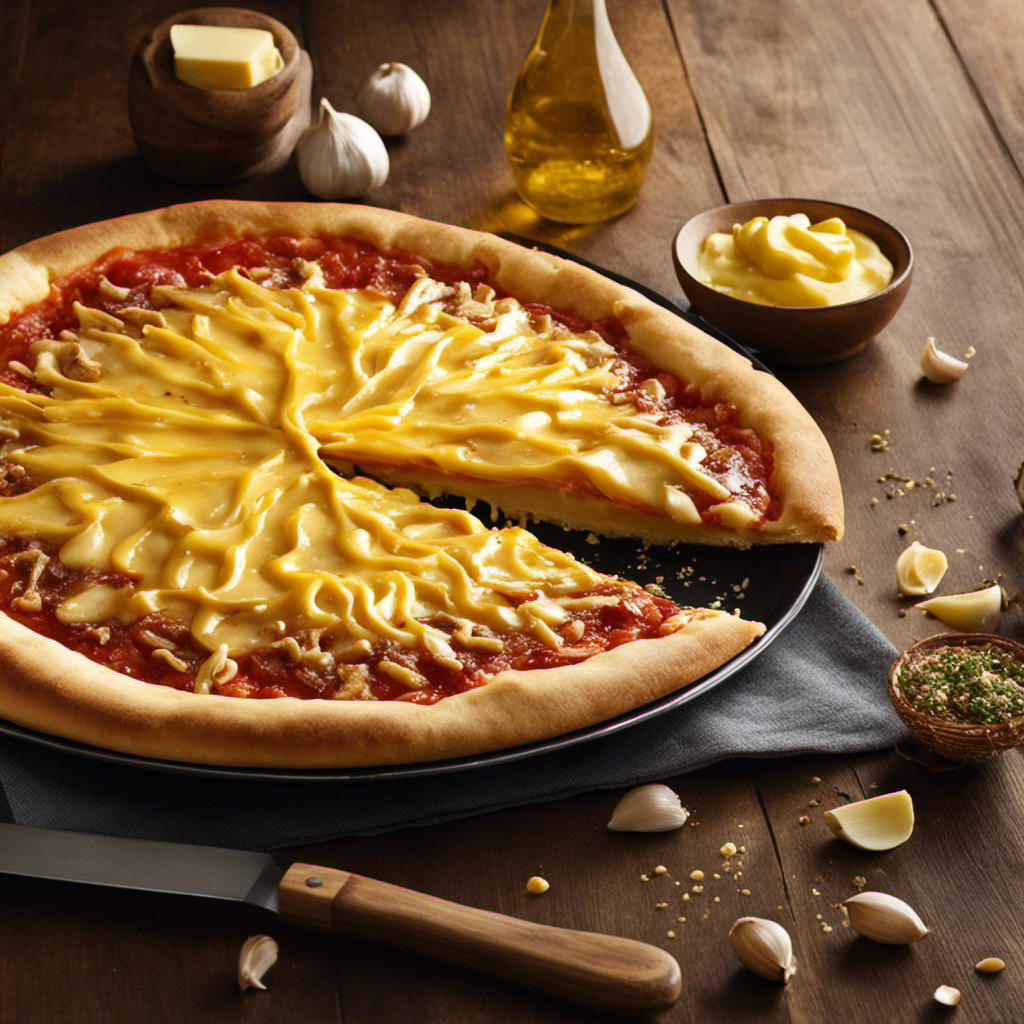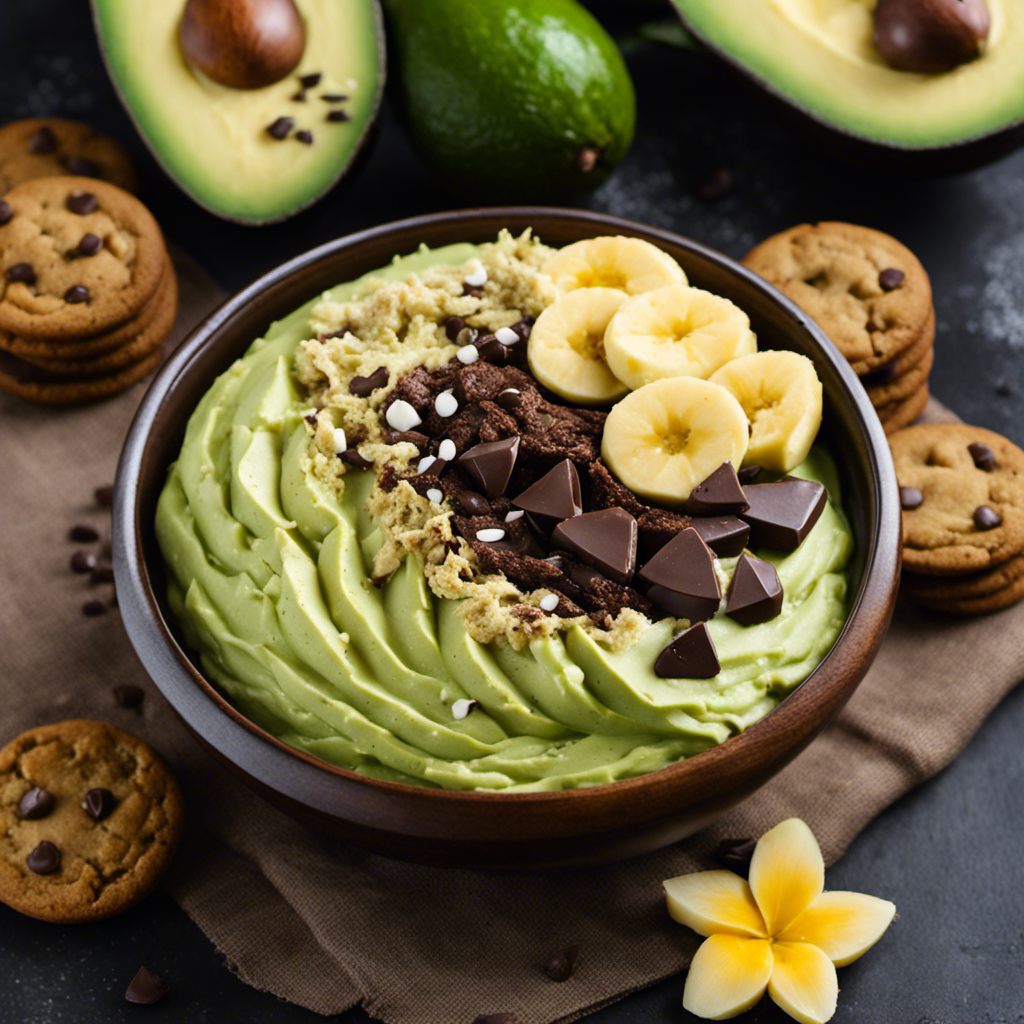As someone who truly appreciates a good steak, I have always thought that the secret to a delicious steak is in the right blend of flavors and cooking techniques. And I can assure you, you don’t need butter to make it incredibly tender.
In this article, I’ll guide you through the art of cooking steak without butter, sharing my tried-and-true methods for selecting the right cut, preparing the steak, and cooking it to absolute perfection.
Get ready to savor a steak that’s both delicious and butter-free.
Key Takeaways
- Look for a well-marbled piece of steak for tenderness and flavor.
- Use alternative fats like olive oil, avocado oil, or coconut oil instead of butter.
- Experiment with different marinades using oil, vinegar, herbs, spices, or citrus juices to enhance taste.
- Grilling, broiling, or pan-searing methods bring out natural flavors without the need for butter.
Choosing the Right Cut of Steak
To choose the right cut of steak, look for a well-marbled piece that will be tender and flavorful when cooked without butter. The marbling helps keep the steak moist and adds flavor.
When it comes to cooking techniques without using butter, try grilling, broiling, or pan-searing the steak. These methods allow the natural flavors of the meat to shine without the need for added fats.
Another way to enhance the taste is by using marinades. A marinade can add extra flavor and help tenderize the meat. Options for marinades include a combination of oil, vinegar, herbs, spices, and even citrus juices.
Preparing the Steak for Cooking
Before you start, make sure you have all the necessary ingredients and tools for preparing your steak without using butter.
When it comes to marinating techniques, there are several options that can enhance the flavor and tenderness of your steak. You can use a mixture of olive oil, garlic, and herbs to create a simple and delicious marinade.
Another alternative is to use a combination of soy sauce, Worcestershire sauce, and brown sugar for a sweet and savory flavor profile.
As for cooking fats, there are many alternatives to butter. You can use olive oil, avocado oil, or even coconut oil for a healthier option. These oils can withstand high heat and will help to create a beautiful sear on your steak.
Seasoning the Steak
For maximum flavor, generously season your steak with a blend of spices and herbs. This will enhance the taste and create a delicious crust on the outside of the steak.
When it comes to marinating techniques, you have a few options. You can either marinate the steak for a few hours in a mixture of oil, vinegar, and your favorite seasonings, or you can use a dry rub and let it sit on the steak for about 30 minutes before cooking. Both methods will infuse the steak with flavor and tenderize the meat.
As for alternative cooking fats, you can use oils like avocado oil or coconut oil, which have high smoke points and add a unique taste to the steak. Another option is to use ghee, a clarified butter that has had the milk solids removed, making it suitable for those who are lactose intolerant or following a dairy-free diet.
Selecting the Cooking Method
One popular cooking method is grilling the steak, which can give it a smoky and charred flavor. However, there are alternative cooking methods that can also yield delicious results.
One such method is pan-searing the steak. This involves heating a skillet over high heat and searing the steak on both sides until it reaches the desired level of doneness.
Another option is broiling the steak in the oven. By placing the steak on a broiler pan and cooking it under the broiler, you can achieve a nice crust on the outside while keeping the meat juicy on the inside.
Whichever cooking method you choose, marinating the steak beforehand can enhance its flavor. By combining various herbs, spices, and acidic ingredients, you can infuse the steak with delicious flavors and tenderness.
Experiment with different marinating techniques to find your favorite combination.
Preheating the Cooking Surface
To preheat the cooking surface properly, make sure it reaches the desired temperature for optimal cooking results. Here are some tips to ensure your cooking surface is adequately preheated:
- Clean the cooking surface thoroughly before preheating to remove any debris or residue.
- Use a high-quality cooking oil, such as avocado oil or grapeseed oil, as an alternative to butter. These oils have a higher smoke point, making them ideal for grilling.
- Preheat the cooking surface on high heat for about 10-15 minutes, or until it reaches the desired temperature. This will help to sear the steak and lock in the juices for a delicious and tender result.
Grilling has several advantages over other cooking methods. It allows for the fat to drip away from the steak, resulting in a healthier meal. Additionally, grilling gives the steak a smoky flavor and a beautiful charred exterior.
Cooking the Steak to Perfection
After preheating the cooking surface, it’s important to monitor the internal temperature of the steak to ensure it is cooked to perfection. Cooking techniques and timing are crucial factors in achieving the desired doneness.
For a rare steak, cook it for about 3 minutes on each side, resulting in an internal temperature of 125°F (52°C).
To achieve medium-rare, cook the steak for 4 minutes on each side, resulting in an internal temperature of 135°F (57°C).
For a medium steak, cook it for 5 minutes on each side, reaching an internal temperature of 145°F (63°C).
If you prefer a medium-well steak, cook it for 6 minutes on each side, achieving an internal temperature of 155°F (68°C).
Lastly, for a well-done steak, cook it for 7 minutes on each side, resulting in an internal temperature of 165°F (74°C).
Remember to let the steak rest for a few minutes before serving to allow the juices to redistribute and ensure a moist and flavorful outcome.
Resting and Serving the Steak
When it comes to resting and serving steak, there are a few key points to keep in mind.
First, allowing the steak to rest for a few minutes before slicing is crucial for achieving optimal juiciness. This allows the juices to redistribute throughout the meat, resulting in a more flavorful and tender bite.
Additionally, the way you slice the steak can greatly impact its tenderness. Cutting against the grain helps to break up the muscle fibers, resulting in a more tender texture.
Resting Time for Juiciness
Let the steak rest for a few minutes to maintain its juiciness. Resting is an essential step in cooking steak, as it allows the juices to redistribute and settle back into the meat. The duration of resting depends on the thickness of the steak, but generally, a resting time of 5-10 minutes is recommended. During this time, the steak continues to cook internally, reaching the desired doneness.
To achieve a juicy steak without using butter, there are alternative cooking methods you can try. One option is grilling the steak, which adds a smoky flavor and helps to seal in the juices.
Another method is pan-searing the steak, which involves cooking it in a hot skillet with a small amount of oil. The high heat quickly sears the surface, creating a flavorful crust while keeping the inside moist and tender.
Lastly, you can also try sous vide cooking, which involves vacuum-sealing the steak and cooking it in a water bath at a precise temperature for a prolonged period. This method ensures even cooking and exceptional juiciness.
Slicing for Optimal Tenderness
To achieve optimal tenderness, it’s important to slice the cooked steak against the grain. Slicing against the grain means cutting perpendicular to the muscle fibers, which helps break them up and results in a more tender bite.
When it comes to slicing techniques, there are a few key things to keep in mind. Firstly, make sure to use a sharp knife to ensure clean cuts. Secondly, let the steak rest for a few minutes after cooking to allow the juices to redistribute, making it easier to slice. Lastly, be sure to slice the steak thinly, as thicker slices can be chewier.
As for marinating methods, marinating the steak before cooking can help tenderize it by breaking down the connective tissues. Choose a marinade that includes acidic ingredients like vinegar or citrus juices, as they help to break down tough proteins.
Sauces to Complement Flavors
For a flavorful addition to your steak, try pairing it with a sauce that complements the flavors. There are many options available that can enhance the taste of your steak without using butter. Here are a few ideas to consider:
-
Chimichurri Sauce: Made with fresh herbs, garlic, vinegar, and different cooking oils like olive oil or avocado oil, this sauce adds a vibrant and tangy flavor to your steak.
-
Red Wine Reduction: A rich sauce made by simmering red wine with shallots, garlic, and beef broth. It adds depth and complexity to your steak.
-
Mushroom Sauce: Sautéed mushrooms cooked in a mixture of broth, wine, and herbs. This sauce provides a savory and earthy taste that complements the richness of the steak.
These sauces, made with alternative ingredients for richness and flavor, are perfect for elevating your steak to the next level. Experiment with different combinations to find your favorite pairing.
Frequently Asked Questions
How Do I Know if a Steak Is Cooked to My Desired Level of Doneness?
To check the doneness of a steak, use a meat thermometer and insert it into the thickest part. For medium-rare, aim for 130-135°F. When cooking steak without butter, consider using alternative fats like olive oil or avocado oil for flavor and browning.
Can I Use a Marinade to Add Flavor to the Steak Instead of Butter?
Yes, using a marinade can add flavor to the steak without using butter. There are many marinade options available, such as teriyaki or garlic herb. Cooking without butter can have health benefits too.
What Are Some Alternative Cooking Methods for Steak Besides Grilling or Pan-Frying?
When cooking steak without butter, there are various alternative cooking methods to consider. These methods include broiling, sous vide, and roasting. Each method can provide a unique flavor and texture to the steak, without the use of butter.
How Long Should I Let the Steak Rest Before Serving?
When it comes to carving a steak, it’s important to let it rest before cutting. This allows the juices to redistribute, resulting in a more tender and flavorful meat.
Are There Any Health Benefits to Cooking Steak Without Butter?
Are there any health benefits to cooking steak without butter? Absolutely! Using alternatives like olive oil or avocado oil can provide heart-healthy fats and reduce saturated fat intake. Plus, it adds a delicious flavor to the steak.
Conclusion
In conclusion, cooking steak without butter is not only possible, but it can also result in a delicious and flavorful dish. By choosing the right cut of steak, preparing it properly, seasoning it to your liking, and selecting the appropriate cooking method, you can achieve a perfectly cooked steak without the need for butter.
So, next time you’re in the mood for a juicy steak, don’t hesitate to try this technique. It’s like unlocking a treasure trove of flavors, sending your taste buds on a thrilling adventure.
